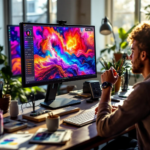What Midjourney and DALL·E Actually Are
When people first hear about Midjourney and DALL·E, the automatic assumption is that they work like Google Image Search with an imagination dial turned to max. But here’s the thing — these aren’t just search tools. They’re generative AI image models, which means they create pictures from scratch based only on the prompt you give them. No templates, no edits on stock images. Entirely synthetic from a blank pixel canvas.
Thank you for reading this post, don't forget to subscribe!DALL·E comes from OpenAI (yes, the same folks behind ChatGPT), and it’s basically a visual creative cousin to the text-predicting brain of GPT. Midjourney, on the other hand, is built by an independent research lab. It’s not bolted onto a chatbot — it exclusively lives inside Discord, and that has a pretty big impact on how you use it. More on that below.
The core idea behind both tools is the same: You enter a text prompt — something like “a cyberpunk fox riding a hoverboard through Times Square at night” — and within seconds, you’ll get a set of unique images that show what the AI thinks that looks like.
Now, that doesn’t mean these tools perform the same way. And they definitely don’t behave nicely in all scenarios. Just understanding where they live — Midjourney on Discord and DALL·E inside OpenAI’s playground or ChatGPT — makes a huge difference in usability, especially if you’re doing this professionally or daily.
When I started testing both tools for client projects (usually brand moodboards or social campaigns), the first barrier was how to even talk to them. DALL·E worked best through the ChatGPT Plus subscription, since it integrated image generation with a conversation thread. Midjourney needed me to join a Discord server and use slash commands inside threads. Two totally different user mental models.
Anyway, if you just want to see some AI-generated art for fun, both will do the job. But for any work that involves iteration, styling, and delivering assets to clients — the devil’s in the details.
At the end of the day, knowing who built the tool, where it runs, and how you’re supposed to interact with it sets the groundwork for choosing the better fit for your use case.
Comparing Image Quality and Output Control
Here’s where things heat up — the actual output. I ran the same prompt across both tools multiple times to compare. What I wanted to generate was simple on the surface: “A surrealist portrait of a woman with leaves for hair, in warm light, 4K, cinematic, editorial.”
Let me walk you through it.
- Midjourney: Sends back four images, all closely aligned with my surreal theme. It felt like I got choices within the same universe. There’s a sense of aesthetic consistency.
- DALL·E: Also gave me four, but the interpretations ranged wildly. One leaned cartoonish, one was near-realistic, and one had a weird childlike vibe that didn’t match the tone.
Sometimes that randomness from DALL·E feels like creativity, but when you’re under deadline and need a specific vibe, Midjourney’s “style bias” (what the devs call their consistent art direction) is a gift. I didn’t need to be overly descriptive to guide it toward the look I wanted.
| Feature | Midjourney | DALL·E |
|---|---|---|
| Image resolution (max) | Roughly 1024×1024 but upscale tool goes larger | Up to 1024×1024 with high clarity |
| Consistent style across outputs | Yes — has recognizable tones | No — can feel disjointed |
| Prompt interpretation | Stylistic, more poetic | Literal, tends to split prompt into visual objects |
| Image variations from one prompt | Smooth cohesive sets | Random/unexpected diversity |
Something I didn’t expect: when I asked for reworks, Midjourney’s /v tool let me tweak images with slight variations, while DALL·E 3 had trouble understanding “slightly different angle” without just redrawing the woman entirely.
If you need reliable visual direction with minimal editing, Midjourney leads here. But if experimentation is part of your process — what happens when I say “golden disco lighting”? — DALL·E’s unpredictability can be useful.
Ultimately, both deliver stunning images, but Midjourney’s polished, stylized feel wins more often if you’re shipping visuals to the client that same day.
Prompt Engineering: What Works Best Where
No image generator is useful if it misunderstands what you want. And holy hell — each one speaks a totally different dialect.
Midjourney rewards poetic, abstract phrases. If you say “dreamy portrait of a child who looks like starlight,” it’ll figure out a visual metaphor. But try that in DALL·E? You’ll get a child literally surrounded by a galaxy — very NASA, less Vogue.
With DALL·E, you’ve gotta be literal. Say exactly what you want in plain terms: “an 8-year-old child against a dark sky background, glowing skin, twinkling lights in the distance, in portrait framing.” It doesn’t guess context — it LEGO-builds your words.
When I tested corporate clients’ prompt workflows, this came up a lot. Writers preferred DALL·E. Designers leaned toward Midjourney. Why? Because Midjourney quietly fills in style cues. Want it to feel like a New Yorker illustration? Just say that. DALL·E will make a literal drawing of a newsstand unless you describe the pen strokes and paper tone.
Using advanced syntax — like aspect ratios (e.g., --ar 16:9) or quality settings (e.g., --q 2) — gives Midjourney a lot of hidden power. DALL·E, in comparison, puts all modifiers into the prompt sentence, which adds bulk but not nearly the same level of tweakability.
To wrap up, if you’re more of a visual thinker who loves moodboarding vibes, Midjourney’s intuitive prompt response shines. If you’re scripting visual outcomes word-for-word, especially from a dev or academic background, DALL·E’s directness serves better.
User Interface and Workflow Integration
Let me be brutally honest: Midjourney felt like walking into a loud party where nobody tells you the rules. You’re suddenly dropped into a public Discord chatroom. Your first prompt publicly triggers a bot, which floods the channel with images. You then have to react with emoji to upscale, remix, or save it. Newbie shock level = high.
DALL·E, especially in ChatGPT Plus, is so much cleaner. You open a chat, write to it like a person, and it replies with images. Suggestions, follow-ups, even context reminders — all part of the conversation thread. It feels like talking to a studio assistant who also happens to know Photoshop.
But here’s a twist: Midjourney is way faster for power users. Once you build some muscle memory, those emoji-style buttons and bots make image creation almost mechanical in speed. I rigged up keyboard macros in Discord and was pumping out styled images every 30 seconds. DALL·E, while more serene, felt slower for batch work.
| Workflow Feature | Midjourney | DALL·E |
|---|---|---|
| Beginner-friendly setup | No – Discord barrier | Yes – ChatGPT/Website UI |
| Asset downloading | Right-click in Discord | Button-click in browser chat |
| Batch generation | Fast with macros | Limited to chat cadence |
So, when it comes to actual usage on tight schedules or collaborative projects, the better tool clearly depends on your tech comfort zone. Midjourney is a command-line DJ set; DALL·E is a guided tour with labels on the paintings.
Overall, the difference in interfaces isn’t minor. It actively shapes the production pace, especially when you’re refining assets instead of just generating for fun.
Real-World Scenarios: Branding, Books, and Storyboards
I spent two weeks prototyping cover concepts for an upcoming indie fantasy author’s book. We ran identical prompts through both tools. Midjourney consistently gave us cover-worthy imagery that looked like it belonged in a bookstore — dramatic lighting, depth of field, painterly effects. DALL·E gave us decent drafts, but often with anatomical quirks (fingers, eyes) and some very flat compositions.
Flip the use case: storyboards. Imagine you’re building a training video and just want placeholder frames of “a woman at a desk,” “person walking through factory,” etc. DALL·E excelled here. Simple prompts plus fast regeneration cycles. Midjourney overcomplicated the same concepts with unnecessary lighting drama or art-style filters I didn’t want.
For branding mockups — say, T-shirts or product labels — Midjourney again pulled ahead. I uploaded logos and used image prompts plus text to place them on hats, mugs, merch shots. DALL·E 3 added support for basic inpainting and reuse of logos, but reflowing text or matching brand colors wasn’t reliable yet.
This also came up in agency client meetings. I used Midjourney to ideate an early visual identity for a concept startup. The clarity of the generated palettes and product scenes helped win over the room in minutes. DALL·E had some wins too, but I just couldn’t trust it to hit the same visual richness unless I did heavy post-editing.
As a final point here: If you’re a solo creator knocking out indie book art — Midjourney feels like having a moody high-end illustrator in your pocket.
Final Thoughts: When to Pick Which
Let’s not pretend one of these wins every category. I treat Midjourney and DALL·E less like competitors and more like Photoshop and Canva — both useful, just for very different goals.
- Go with Midjourney if you care about composition, polish, styling, or aesthetic fidelity. It thrives in folders and pitch decks.
- Lean on DALL·E when you need conversational ideation or quick literal drafts that match basic briefing language.
It’s not about which model is smarter — it’s about whether you’re ready to wrestle Discord workflows or whether you need PG-friendly images inside a polished chat.
To sum up, whichever you choose should reflect the way you think and build — not whatever brand gets buzzier this month.






